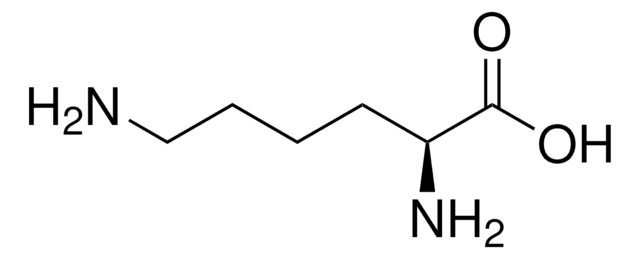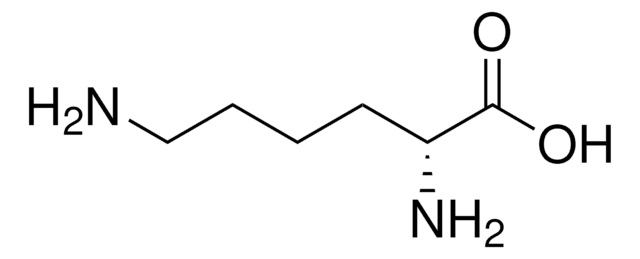Wichtige Dokumente
62840
L-Lysin
≥98.0% (NT), for peptide synthesis
Synonym(e):
(S)-2,6-Diaminocaprosäure
About This Item
Empfohlene Produkte
Produktbezeichnung
L-Lysin, crystallized, ≥98.0% (NT)
Qualitätsniveau
Assay
≥98.0% (NT)
Form
solid
Optische Aktivität
[α]20/D +26.0±1.0°, c = 2% in 6 M HCl
Qualität
crystallized
Eignung der Reaktion
reaction type: solution phase peptide synthesis
Verunreinigungen
≤1% water
mp (Schmelzpunkt)
215 °C (dec.) (lit.)
~215 °C (dec.)
Löslichkeit
H2O: 0.1 g/mL, clear, colorless to very faintly greenish-yellow
Anwendung(en)
peptide synthesis
SMILES String
NCCCC[C@H](N)C(O)=O
InChI
1S/C6H14N2O2/c7-4-2-1-3-5(8)6(9)10/h5H,1-4,7-8H2,(H,9,10)/t5-/m0/s1
InChIKey
KDXKERNSBIXSRK-YFKPBYRVSA-N
Suchen Sie nach ähnlichen Produkten? Aufrufen Leitfaden zum Produktvergleich
Allgemeine Beschreibung
Anwendung
Lagerklassenschlüssel
11 - Combustible Solids
WGK
WGK 1
Flammpunkt (°F)
Not applicable
Flammpunkt (°C)
Not applicable
Persönliche Schutzausrüstung
Eyeshields, Gloves, type N95 (US)
Hier finden Sie alle aktuellen Versionen:
Besitzen Sie dieses Produkt bereits?
In der Dokumentenbibliothek finden Sie die Dokumentation zu den Produkten, die Sie kürzlich erworben haben.
Kunden haben sich ebenfalls angesehen
Protokolle
Separation of L-Alanine; Glycine; L-Valine; L-Leucine; L-Isoleucine; L-Proline; L-Methionine; L-Serine; L-Threonine; L-Phenylalanine; L-Aspartic acid; L-4-Hydroxyproline; L-Cysteine; L-Glutamic acid; L-Asparagine; L-Lysine; L-Glutamine; L-Histidine; L-Tyrosine; L-Tryptophan; L-Cystine
Unser Team von Wissenschaftlern verfügt über Erfahrung in allen Forschungsbereichen einschließlich Life Science, Materialwissenschaften, chemischer Synthese, Chromatographie, Analytik und vielen mehr..
Setzen Sie sich mit dem technischen Dienst in Verbindung.


